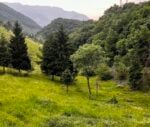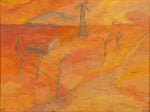Edoardo Caimi – (((8)))
 (1200x800).jpg)
In occasione della Milano Art Week 2022 L.U.P.O. presenta (((8))), mostra personale di Edoardo Caimi (b. 1989).
Comunicato stampa
In occasione della Milano Art Week 2022 L.U.P.O. presenta (((8))), mostra personale di Edoardo Caimi (b. 1989).
Con (((8))), Edoardo Caimi s’inoltra nel paesaggio futuribile del nostro secolo, a partire da un soggetto che da anni ne ricalca con forza sogni e incubi: la figura del sopravvissuto, lo spettro che abita le immagini dei paesaggi a venire.
Caimi cerca di costruire un’immagine, uno scenario estetico e sensoriale, che affonda le sue radici nei sogni di distruzione e desolazione, nelle wastelands, nei deserti e nelle pianure prosciugate. Ed è dal paesaggio che la mostra comincia, da un sorvolo che esplora un paesaggio abbandonato: uno sguardo di un drone, che alla stregua di un rabdomante insegue i segnali, sogni e memorie sepolti nella terra.
I paesaggi dai cui Caimi prende le mosse sembrano quelli dei luoghi in cui è cresciuto, le pianure. Edifici e resti industriali, zolle di terra e lunghi steli d’erba selvatica.
(((8))) fa i conti con ciò che si è perso, con una smemoratezza che, proiettata al futuro, fa dell’avvenire uno spettro. La questione è ciò che resta, o resterebbe. È chiedersi cosa svolge il ruolo del ricordo in uno sfondo opaco e disabitato.
On the occasion of the Milano Art Week 2022 L.U.P.O. presents (((8))), solo exhibition by Edoardo Caimi (b. 1989).
With (((8))), Edoardo Caimi ventures into the futuristic landscape of our century, starting with a subject that for years has strongly echoed his dreams and nightmares: the figure of the survivor, the spectre
that inhabits the images of the landscapes to come.
Caimi seeks to construct an image, an aesthetic and sensory scenario, rooted in dreams of destruction and desolation, in wastelands, deserts and drained plains. And it is from the landscape that the exhibition begins, from a flyover that explores an abandoned landscape: a drone’s gaze, like a diviner, chasing signals, dreams and memories buried in the earth.
The landscapes from which Caimi takes his cue seem to be those of the places where he grew up, the plains. Buildings and industrial remains, clods of earth and long stalks of wild grass.
(((8))) he comes to terms with what has been lost, with a forgetfulness that, projected into the future, turns the future into a spectre. The question is what remains, or would remain. It is to ask what plays the role of memory in an opaque and uninhabited background.



